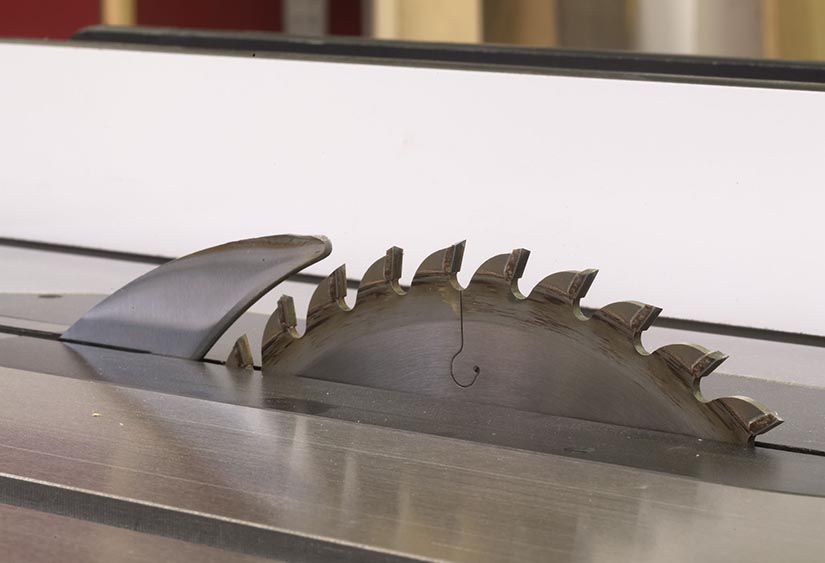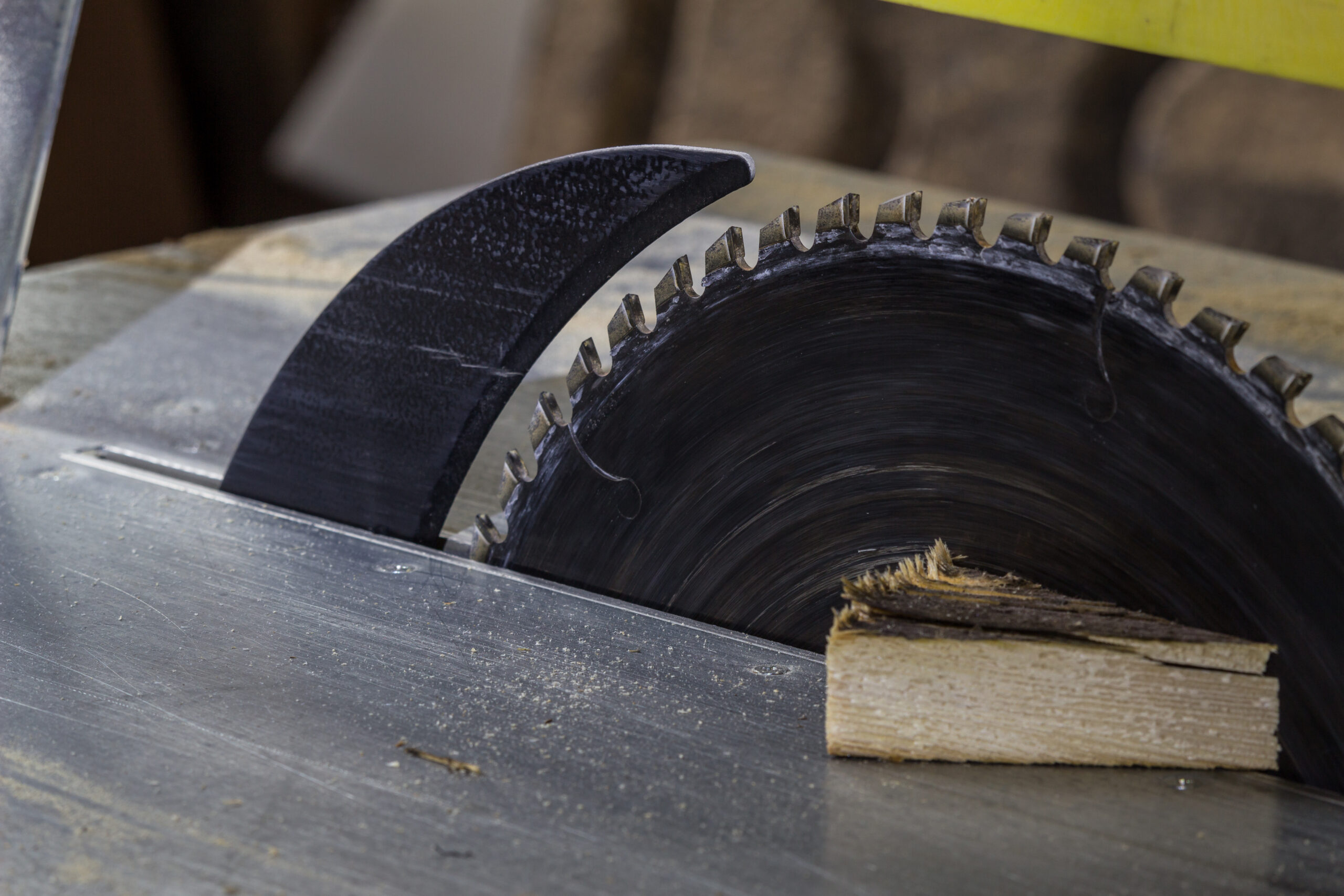When it comes to using a table saw, safety is always a top priority. And one important safety feature to consider is the riving knife. But what exactly is a riving knife, and does a table saw really need one? In this article, we’ll answer that question and explore the benefits of using a riving knife when operating a table saw. So, let’s dive in and find out if a table saw truly needs a riving knife!
A riving knife is a safety device that plays a crucial role in preventing kickback while using a table saw. It’s a metal plate positioned just behind the saw blade and rises and falls with the blade during cuts. Its purpose is to keep the kerf, the cut made by the blade, open and prevent the wood from pinching the blade, causing dangerous kickback.
While some table saws come with a built-in riving knife, others may require users to install one separately. So, whether a table saw needs a riving knife depends on the model you’re using and the safety features it offers. However, it’s important to note that having a riving knife greatly enhances the safety of the table saw and reduces the risk of kickback accidents. So, it’s highly recommended to use one whenever possible.
Now that we know what a riving knife is and its purpose, it’s clear that using a table saw with a riving knife is vital for safety. By keeping the kerf open and preventing kickback, a riving knife helps prevent accidents and ensures a smooth, controlled cutting experience. So, if you’re planning to use a table saw, always prioritize safety and make sure to use a riving knife if your saw is equipped with one or install one separately if needed. Stay safe and happy woodworking!

Does a Table Saw Need a Riving Knife?
Table saws are a popular and versatile tool in woodworking. They are used for a variety of tasks, from ripping boards to making intricate cuts. However, safety is paramount when using a table saw, and one safety feature that often comes into question is the riving knife. In this article, we will explore the purpose of a riving knife, its benefits, and the considerations for whether a table saw needs one.
What is a Riving Knife?
A riving knife is a safety device that is installed just behind the saw blade on a table saw. Its purpose is to minimize the risk of kickback, which occurs when a workpiece gets caught and thrown back towards the operator at high speed. The riving knife is typically a flat, metal blade that is positioned in line with the cutting edge of the saw blade. Unlike a splitter, which remains fixed in position, a riving knife moves up and down with the blade.
The primary function of a riving knife is to prevent the workpiece from contacting the back of the saw blade during a cut. By keeping the cut kerf open, it prevents the workpiece from closing in on the blade and causing it to bind or kickback. Additionally, the riving knife helps to minimize the risk of the workpiece getting trapped between the blade and the fence, reducing the chances of kickback even further. Overall, the riving knife acts as a safety mechanism that helps to maintain control and stability during table saw operations.
Benefits of a Riving Knife
1. Kickback Prevention: The primary advantage of using a riving knife is its ability to prevent kickback. Kickback can be extremely dangerous and has the potential to cause serious injury. A properly aligned and installed riving knife significantly reduces the risk of kickback by keeping the cut kerf open and preventing the workpiece from getting trapped or pinched.
2. Improved Cutting Accuracy: When using a riving knife, the workpiece is less likely to bind or twist during a cut, resulting in cleaner and more accurate cuts. This is especially important when performing complex cuts or working with larger workpieces where even slight deviations can affect the final result.
3. Versatility: A riving knife can accommodate various cutting operations, including non-through cuts, bevel cuts, and dado cuts. By adjusting the height and position of the riving knife, woodworkers can ensure that the workpiece is properly supported and guided throughout the cut, regardless of its complexity.
Considerations for Using a Riving Knife
1. Workpiece Thickness: The thickness of the workpiece plays an important role in determining whether a riving knife is necessary. For thinner materials, such as plywood or thinner boards, the risk of kickback is generally lower. However, as the thickness of the material increases, the chance of kickback becomes more significant, making the use of a riving knife highly recommended.
2. Type of Cuts: Different types of cuts require different levels of precision and stability. For basic rip cuts on thinner stock, a riving knife may not be absolutely essential. However, when performing crosscuts, bevel cuts, or cuts on thicker materials, a riving knife becomes increasingly important. It helps maintain proper alignment and reduces the potential for kickback.
3. Operator Skill and Experience: The skill level and experience of the operator also influence the need for a riving knife. Experienced woodworkers who are adept at controlling their material and maintaining proper technique may feel comfortable working without a riving knife in certain situations. However, for beginners or less experienced individuals, the added safety provided by a riving knife is invaluable and should always be utilized.
In conclusion, while it may be possible to use a table saw without a riving knife in certain circumstances, it is highly recommended to use one for enhanced safety and improved cutting accuracy. A riving knife serves as a crucial safety device, helping to prevent kickback and maintain control during table saw operations. By understanding its purpose and benefits, woodworkers can make informed decisions about whether their table saw needs a riving knife for specific tasks. Remember, safety should always be the top priority when working with power tools.
Key Takeaways: Does a Table Saw Need a Riving Knife?
- A riving knife is an important safety feature for a table saw.
- It helps prevent kickback, which is when the wood piece gets thrown back towards the operator.
- Using a riving knife can reduce the chances of accidents and injuries while using a table saw.
- Some table saws come with a built-in riving knife, while others may require you to purchase and install one separately.
- Always consult the manufacturer’s instructions to determine if your specific table saw model needs a riving knife.
Frequently Asked Questions
Here are some commonly asked questions about table saws and riving knives.
Why is a riving knife important on a table saw?
A riving knife is an essential safety device on a table saw. It is a metal blade that sits just behind the saw blade and helps prevent kickback. Kickback is when the workpiece gets thrown back towards the user at a high speed. The riving knife minimizes the risk of kickback by keeping the workpiece from getting pinched between the blade and the fence. It also helps keep the workpiece aligned, reducing the chances of binding or binding-related accidents.
Without a riving knife, kickback can occur more frequently and with greater force, posing a serious safety risk. It is recommended to always use a riving knife when operating a table saw to ensure safer and more accurate cuts.
Can I remove the riving knife from my table saw?
While it is generally recommended to keep the riving knife on your table saw for safety reasons, there may be situations where you might want to remove it temporarily. For example, when making non-through cuts or using certain dado blades, the riving knife may interfere with the operation. However, it is crucial to weigh the risks of removing the riving knife against the benefits of convenience.
Remember that removing the riving knife increases the risk of kickback, especially when ripping narrow stock or cutting large sheets of plywood. If you choose to remove the riving knife, make sure to always follow proper safety procedures, use other safety devices such as push sticks, and be extra cautious to avoid accidents.
What are the alternatives to a riving knife?
If your table saw doesn’t have a riving knife or you need an alternative solution, there are a few options available. One alternative is to use a splitter. A splitter is a similar device to a riving knife and can help prevent kickback by maintaining a proper distance between the blade and the workpiece.
Another alternative is using a featherboard. A featherboard is a flexible, spring-loaded device that applies pressure against the workpiece, keeping it snug against the fence and reducing the chances of kickback. However, it’s important to note that while these options can provide some level of safety, they may not be as effective as a riving knife in preventing kickback.
Do all table saws have a riving knife?
No, not all table saws come with a riving knife. While many modern table saw models are equipped with a riving knife as a standard safety feature, some older or budget-friendly table saws may not have this feature. If your table saw doesn’t have a riving knife, it’s important to explore alternative safety devices such as splitters or featherboards to minimize the risk of kickback.
If safety is a top priority for you, it’s advisable to consider upgrading to a table saw that includes a riving knife or explore retrofitting options available for your current table saw model.
Are there any disadvantages to using a riving knife?
While riving knives are highly beneficial for safety, there can be a couple of minor drawbacks. One potential disadvantage is that the presence of a riving knife may restrict the thickness of material you can cut on the table saw. Some riving knives may have limitations on the maximum height of the blade that can be used.
Additionally, when changing the blade or making certain cuts, you may need to remove or adjust the riving knife. This can add a little extra time and effort to your workflow. However, considering the significant safety benefits, these minor inconveniences are usually outweighed by the advantages of using a riving knife.

Summary
So, let’s quickly wrap up what we’ve learned about table saws and riving knives! A riving knife is an important safety feature that helps prevent kickbacks by keeping the wood from pinching the blade. It’s especially crucial for beginners and less experienced users. Without a riving knife, kickbacks can be dangerous and cause serious injuries. However, some older table saws might not have a riving knife, so it’s important to use other safety measures like a splitter if that’s the case. Remember, safety should always come first when using a table saw, so make sure to follow all the guidelines and precautions.
In conclusion, a table saw can benefit from having a riving knife, especially for safety reasons. However, if your table saw doesn’t have one, don’t worry! Just make sure to use other safety measures and always prioritize your well-being while using any tools. Stay safe and have fun woodworking!
